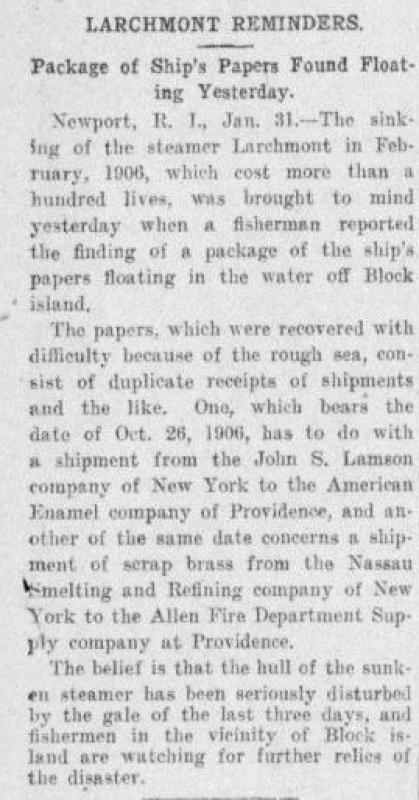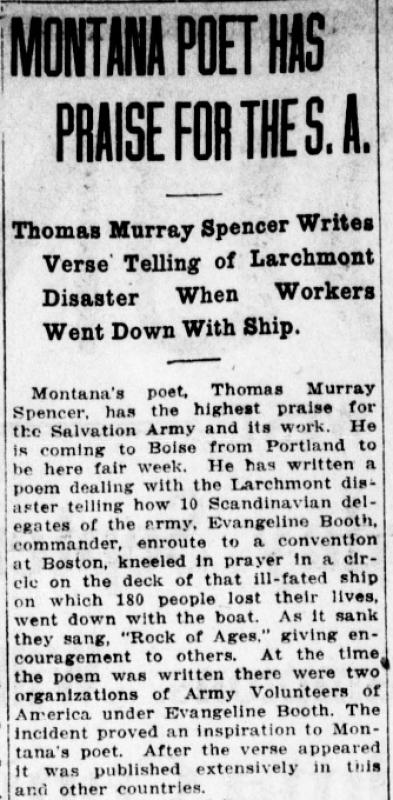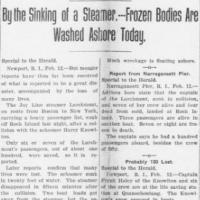The Sinking of the Larchmont
On Tuesday, February 12, 1907, the Larchmont departed from Rhode Island with an estimated 150 passengers and 30 crewmembers aboard. The exact number of passengers is still unknown. As the Larchmont left the harbor and began its voyage to New York it was met with gale force winds up to 60 miles an hour, and 20-foot waves. The temperature was below freezing, quickly covering the deck in sheets of ice. Three miles out, the Larchmont encountered the Harry Knowlton and the two vessels collided, ripping an enormous hole in the side of the Larchmont. As panic set in on the Larchmont, the passengers and crew were left in total darkness amid the chaos. For the few that made it on deck, they were met with freezing water and whipping winds. Within fifteen minutes after colliding with the Harry Knowlton, the Larchmont slipped beneath the surface of the water amongst the crashing waves. The passengers who made it to a lifeboat quickly succumbed to frostbite and in most cases froze to death. On that fateful night, 150 people perished with Ezra Gerry’s being one of the bodies later identified.
As the currents pounded the hull of the sunken ship, pieces from the cargo hold began to float to the surface. Fishermen from Rhode Island found debris believed to be from the Larchmont. The material that floated to the surface consisted of duplicate receipts from purchases of scrap brass purchased in 1906. By collecting these documents, it helped to shed a light on what was in the Larchmont’s cargo hold during that time.
Once the sinking of the Larchmont became known, numerous people came to help in the recovery of the frozen bodies being washed ashore. Many of the rescuers came from the Schooner Elsie, SS. Kentucky, and the Lifesaving Service. The rescuers risked hypothermia and freezing conditions to work tirelessly to collect as many bodies as possible.
Shortly after the Larchmont sank, numerous frozen bodies of the passengers onboard began to wash up ashore. The few lifeboats that were able to be launched began to drift ashore with the bodies completely froze solid. The majority of the deaths were caused by hypothermia, and not due to drowning. The few that did survive suffered from severe frostbite and subsequently had to undergo amputations of the damaged limbs.
The famous Montana poet Thomas Murray, who had previously written numerous famous poems, was impressed by the actions of the 10 Scandinavian Salvation Army that he wrote a poem twelve years after the disaster as a way to honor those on board. He was inspired by the story of the delegates kneeling on the hurricane deck among the chaos around them as the Larchmont sank. As they knelt and held hands, they sang “The Rock of Ages” which was used as a symbol of hope and encouragement for those around them.
Shortly after the Larchmont sank, many pieces of his hull and cargo began to break off due to the underwater currents and float to the surface. Those pieces consisted of pieces of the deck, numerous life preservers marked Steamer Larchmont and a door from one of the staterooms.
The Coast Guard became concerned with more debris floating giving the possibility of damaging ships and their propellers. The idea of using a torpedo was discussed as a way to possibly free the bodies entombed in the hull.
Ezra Gerry’s body was identified as a crew member aboard the Larchmont the night it sank in the Rhode Island Sound. Gerry’s body was identified by one of the surviving members of the disaster, and his grandmother was informed of his passing through the Joy Line company via telegraph. While serving aboard the Larchmont, Gerry was a pantryman. Although the states this address as being unknown, it was later discovered that he was from Pensacola, Florida.
One of the articles found details the idea of using a torpedo or dynamite to destroy the hull of the Larchmont to attempt to release the frozen bodies remaining in the hull of the ship. The decision to blow up the hull was changed due to the possible debris floating, and the damage it could do to other ships. The final decision to keep the Larchmont undisturbed allowed the hull to become a tomb for those who perished that fateful night.
“List of Those Identified from Awful Larchmont Wreck”. Boston Herald. Newspaper. eLearning. 15, Feb. 1907.
“M’vey Explains”. The Topeka State Journal. Newspaper. eLearning. Created 14 Feb. 1907.
National Endowment for the Humanities. "The Barre Daily Times. (Barre, Vt.) 1897-1959, June 23, 1911, Page 1, Image 1." News about Chronicling America RSS. Accessed April 03, 2019. https://chroniclingamerica.loc.gov/lccn/sn91066782/1911-06-23/ed-1/seq-1/.
National Endowment for the Humanities. "Evening Capital News. (Boise, Idaho) 1901-1927, September 24, 1919, Page 6, Image 6." News about Chronicling America RSS. Accessed April 03, 2019. https://chroniclingamerica.loc.gov/lccn/sn88056024/1919-09-24/ed-1/seq-6/.
National Endowment for the Humanities. "The Washington Times. (Washington [D.C.]) 1902-1939, April 21, 1907, Page 6, Image 6." News about Chronicling America RSS. Accessed April 03, 2019. https://chroniclingamerica.loc.gov/lccn/sn84026749/1907-04-21/ed-1/seq-6/.
National Endowment for the Humanities. "Spirit of the Age. [volume] (Woodstock, Vt.) 1845-1913, April 06, 1907, Image 1." News about Chronicling America RSS. Accessed April 03, 2019. https://chroniclingamerica.loc.gov/lccn/sn84023296/1907-04-06/ed-1/seq-1/.
National Endowment for the Humanities. "Evening Star. [volume] (Washington, D.C.) 1854-1972, February 13, 1907, Page 3, Image 3." News about Chronicling America RSS. Accessed April 03, 2019. https://chroniclingamerica.loc.gov/lccn/sn83045462/1907-02-13/ed-1/seq-3/
National Endowment for the Humanities. "Palestine Daily Herald. (Palestine, Tex.) 1902-1949, February 12, 1907, Image 1." News about Chronicling America RSS. Accessed April 03, 2019. https://chroniclingamerica.loc.gov/lccn/sn86090383/1907-02-12/ed-1/seq-1/.
“Steamer and about 150 Lost”. New York Tribune. Newspaper. eLearning. Created 13 Feb. 1907.
“Awful Harvest of Death in Larchmont Disaster”. The Pensacola Journal. Newspaper. eLearning. Created 14, Feb. 1907.
Wreck of Steamer Larchmont, Feb. 11, 1907. Collecting dead bodies along the beach, Block Island. H. Ladd Walford. Picture. Website. https://www.flickr.com/photos/hollywoodplace/41788782430. Created 11 Feb. 1907







